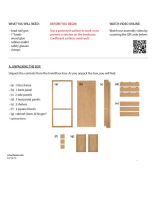
SKU 46309 Page 8For technical questions, please call 1-800-444-3353.
Anytime any maintenance or repairs are done, FIRST:
1. Disconnect the Nailer from the air hose.
2. Empty the Magazine (60) completely.
3. Attempt to re the Nailer into a piece of scrap wood to ensure that it is disconnected
and is incapable of ring any brads.
4. Always leave the Magazine (60) open during maintenance. The Magazine is
spring-loaded and may cause parts or a nail to y out of the Nailer.
Troubleshooting Guide
Stop using the Brad Nailer immediately if any of the following problems occur.
Repairs and part replacements must be done only by a qualied technician.
All procedures in bold on this chart are to be attempted only be a qualied technician.
Problem Likely Cause Solution
Air leaking at Trigger area.
O-Rings in Trigger Valve housing are
damaged.
Replace O-Rings and check contact
trip operation.
Air leaking between Housing and
Nose.
1. Loose screws in Housing.
2. Damaged O-Rings/Bumper (17).
1. Tighten screws.
2. Replace O-Rings or Bumper (17).
Air leaking at Trigger Valve Stem. O-Rings or Seals are damaged. Replace O-Rings or Seals.
Air leaking between Housing and
Cap.
1. Loose screws.
2. Damaged Gasket (7).
1. Tighten Screws.
2. Replace Gasket (7).
Runs slowly or has power loss.
1. Insufcient oil.
2. Broken Spring in Cylinder Cap.
3. Exhaust (1) is blocked.
1. Lubricate as instructed.
2. Replace Compression Spring (6).
3. Replace damaged parts.
Nailer skips a nail.
1. Worn Bumper (17) or damaged
Pusher Spring.
2. Dirt in Driver Guide (52).
3. Inadequate airow to Nailer.
4. Worn or dry O-Ring on Piston.
5. Damaged O-Ring on Trigger
Valve.
6. Cap Gasket (7) leaking.
1. Replace Bumper (17) or Pusher
Spring.
2. Clean Channels in Driver Guide (52).
3. Check hose and compressor ttings.
4. Replace or lubricate O-Rings.
5. Replace O-Rings.
6. Replace Gasket (7).
Nails are jammed.
1. Guide on driver is worn.
2. Nails are wrong size or damaged.
3. Magazine or Nose screws are
loose.
4. Drive Pin (46) is damaged.
1. Replace Guide.
2. Use correct, undamaged nails.
3. Tighten screws.
4. Replace Drive Pin (46).
Nailer will not drive down tight.
1. Rounded Drive Pin (46) slipping
off nail crown.
2. Lack of air pressure.
3. Slow cycling and loss of power.
1. Replace Drive Pin (46).
2. Supply correct pressure (55-95 PSI).
3. Check Compression Spring (6) for
broken coils or reduced length.
Make sure Exhaust (1) is clear.
Blade driving nail too deeply.
Worn Bumper (17) and/or Piston
Spacer.
Replace either or both parts.
All procedures in bold on this chart are to be attempted only be a qualied technician.













